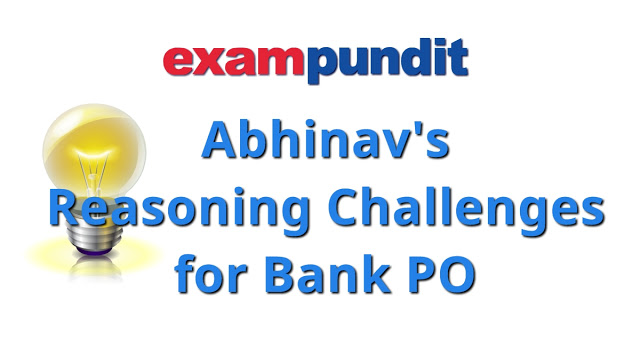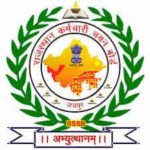Hello and welcome to exampundit . So here is the Abhinav’s Reasoning Challenges for Bank PO Exams 2016.
The rules are same as the fighter’s puzzle challenges(which will come back).
Abhinav will conduct and help everyone along with S Dixit, the fighter and Chitrarth who will monitor/feature/delete any other comments.
Directions
(1-5): Each of the questions below consists of a question and two
statements
(1-5): Each of the questions below consists of a question and two
statements
numbered I and II given below it. You
have to decide whether the data provided in the
have to decide whether the data provided in the
statements are sufficient to answer
the question. Read both the statements are sufficient and
the question. Read both the statements are sufficient and
give answer.
1) if the data in statement I alone
are sufficient to answer the question, while the data in
are sufficient to answer the question, while the data in
statement II alone are not sufficient
to answer the question.
to answer the question.
2) if data in statement II alone is
sufficient to answer the question, while the data in
sufficient to answer the question, while the data in
statement I alone are not sufficient
to answer the question.
to answer the question.
3) if the data in both the statements
I and II together are necessary to answer the question.
I and II together are necessary to answer the question.
4) if the data either in statement I
alone or in statement II alone are sufficient to answer the
alone or in statement II alone are sufficient to answer the
question.
5) if the data in both statements I
and II are not sufficient to answer the question.
and II are not sufficient to answer the question.
1. There are seven letters M, S, L, I,
P, R and E. Can the word PRELIMS be formed?
P, R and E. Can the word PRELIMS be formed?
I. I is placed third to the right of
R. M is placed second to the right of L. M is not last letter of
R. M is placed second to the right of L. M is not last letter of
the word.
II. P is placed third to the left of L
and E is placed adjacent to L. S is placed second to the
and E is placed adjacent to L. S is placed second to the
right of I.
2. Point M is in which direction with
respect to Point X?
respect to Point X?
I. Point R is to the north of Point X.
Point L is to the south of Point M and X.
Point L is to the south of Point M and X.
II. Point T is to the east of Point J,
which is to the south of Point X. Point P is to the north of
which is to the south of Point X. Point P is to the north of
Point M and to the west of Point T.
3. Among A, B, C, D, E and F, is A
greater than C?
greater than C?
I. B is equal to D, who is equal to or
smaller than A. E is greater than or equal to D and
smaller than A. E is greater than or equal to D and
smaller than or equal to C.
II. A is greater than or equal to B,
who is smaller than or equal to E, who is greater than or
who is smaller than or equal to E, who is greater than or
equal to D, who is greater than C.
4. A six –storey building with floors
numbered 1, 2, 3, 4, 5 and 6 are occupied by five
numbered 1, 2, 3, 4, 5 and 6 are occupied by five
different people, namely A, B, C, D
and E. The floor number 3 is vacant. On which of the
and E. The floor number 3 is vacant. On which of the
floors does A live?
I. C lives on an even-numbered floor.
A lives on the floor immediately above C’s floor.
A lives on the floor immediately above C’s floor.
II. B lives on an even-numbered floor.
B does not live above or below the vacant floor. Only
B does not live above or below the vacant floor. Only
one person lives between B’s and C’s
floor. D lives immediately below E’s floor.
floor. D lives immediately below E’s floor.
5. Six people Rahul, Rajeev, Raman,
Ravi, Rohit and Raghu are sitting around a circular
Ravi, Rohit and Raghu are sitting around a circular
table facing the centre.
What is Rajeev’s position with respect
to Raghu?
to Raghu?
I. Only two people sit between Raman
and Rohit, Raghu sits second to the left of Rohit. Ravi
and Rohit, Raghu sits second to the left of Rohit. Ravi
and Rajeev are immediate neighbours of
each other.
each other.
II. Rajeev is an immediate neighbour
of Ravi. There are only two persons between Rajeev
of Ravi. There are only two persons between Rajeev
and Rahul. Raghu is an immediate neighbour of Rahul, but not of
Ravi.
Ravi.
Directions
(6-7): These questions are based on the following information
(6-7): These questions are based on the following information
Out of seven people – A, B, C, D, E, F
and G, four are to be selected
and G, four are to be selected
1. At least one of E or B must be
selected and at most one between A or D can be selected
selected and at most one between A or D can be selected
2. Either C or D must be selected.
3. A, F and G cannot be selected
together.
together.
6. If A is selected then who must be
selected?
selected?
1) D 2) F
3) G 4) C 5) None of these
3) G 4) C 5) None of these
7. If neither A nor D is selected,
then in how many different ways can be four persons be
then in how many different ways can be four persons be
selected?
1) Three 2) Four 3) Five 4) Two
5) None of these
5) None of these
Directions
(8-11): In these questions, certain symbols have been used to indicate
relationships between elements as follows:
(8-11): In these questions, certain symbols have been used to indicate
relationships between elements as follows:
A * B means A is either
equal to or greater than B.
equal to or greater than B.
A $ B means A is equal
to B.
to B.
A £ B means A is either
equal to or smaller than B.
equal to or smaller than B.
A & B means A is
smaller than B.
smaller than B.
A @ B means A is greater
than B
than B
8).
Statements: R * H, T & H, H * B
Statements: R * H, T & H, H * B
Conclusions:
I. R $ B
II. R @ B
III. R @ T
1) I and II only follows
2) Either I or II and
III only follows
III only follows
3) Only I follow
4) II and III only
follows
follows
5) None of these
9).
Statements: Y $ V, H $ S, V * S
Statements: Y $ V, H $ S, V * S
Conclusions:
I. S £ H
II. H £ V
III. Y * S
1) Only II follows
2) Only I and II follows
3) Only III follows
4) Only II and III
follows
follows
5) None of these
10).
Statements: M @ T, O @ R, O & T
Statements: M @ T, O @ R, O & T
Conclusions:
I. O £ M
II. R & T
III. M @ R
1) Only I and II follows
2) Only II and III
follows
follows
3) Only I and III
follows
follows
4) None follows
5) None of these
Regards
Team ExamPundit
This post was last modified on November 27, 2017 8:55 am





